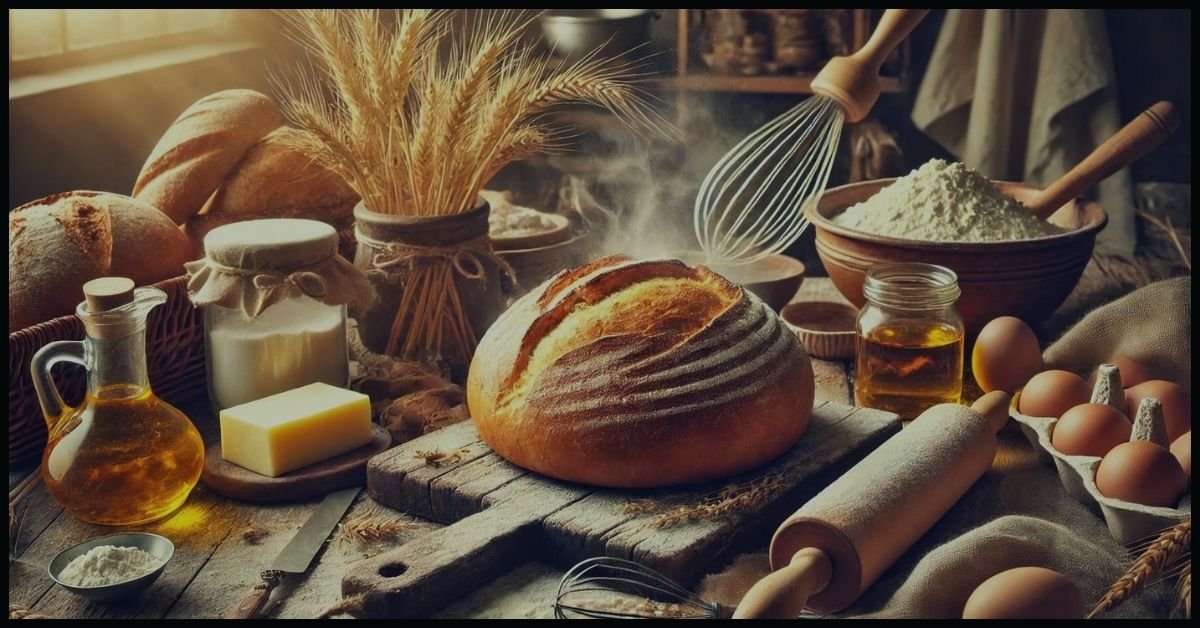Making bread at home can be a rewarding experience, but it also comes with challenges, especially if you are new to baking. To help you overcome these obstacles and achieve the perfect loaf, we’ve compiled the top 5 tips for making bread. Whether you’re a beginner or an experienced baker, these tricks will ensure better results.
Choose the Right Ingredients: Quality and Freshness Matter
Choosing the right ingredients is one of the most essential steps to making good bread. Using high-quality flour, fresh water, pure salt, and active yeast will make a massive difference in the flavor and texture of your bread.
Flour: The Foundation of Every Good Bread
Flour is the main ingredient in any bread recipe. The flour’s quality directly affects the bread’s texture, flavor, and structure. For lighter and airier breads, use strong flour, which is high in protein. You can mix whole grain flour for denser and more flavorful breads.
Yeast: Key to the Perfect Rise
Yeast is the ingredient that makes the bread rise. It’s essential to ensure that your yeast is active and fresh. If you use dry yeast, test it by dissolving it in warm water with a pinch of sugar before adding it to the dough. If it doesn’t foam, the yeast is inactive.
Water: The Hidden Ingredient
Though water is the least essential ingredient, it plays a vital role in the bread’s texture. Always use lukewarm water, as cold water can slow the yeast’s growth, and hot water can kill it.
Proper Kneading: The Key to a Soft and Elastic Dough
Kneading the dough is essential for developing gluten, giving the bread structure and texture. Proper kneading also makes the dough elastic and smooth, allowing it to trap air and expand during the rise.
Kneading Techniques
You can knead the dough by hand or use a stand mixer. Hand kneading requires patience but allows you to feel when the dough has reached the right texture. It would help to knead the dough until it is smooth and elastic, which usually takes about 10-15 minutes by hand.
The Windowpane Test
A helpful trick is to perform the “windowpane test” to check if you’ve kneaded enough. Take a small piece of dough and stretch it between your fingers; if you can do this without it tearing and it forms a thin film, your dough is ready.
Rise Time: Don’t Rush the Process
The rising time is crucial for the bread to develop its flavor and texture. During this time, the yeast produces gases that increase the dough and strengthen the gluten.
The Importance of the First Rise
The first rise, known as fermentation, is when the dough doubles. This process can take 1 to 2 hours, depending on the room temperature. If it’s cold, the process will be slower; it may happen more quickly in warmer environments. Don’t take your time; giving the dough the right amount of time ensures good texture and flavor.
Second Rise or Final Proof
After shaping your bread, let it rest for a second rise. This stage is crucial as it helps the dough relax and attain its final shape. Allow the bread to rise 30-60 minutes before baking, making it fluffier.
Perfect Baking: Control Temperature and Time
Baking is the final phase and one of the most critical steps. A common mistake is baking the bread at an incorrect temperature or not baking it long enough.
Preheat the Oven
Always preheat the oven to the correct temperature before putting the bread inside. Most recipes call for an oven temperature of 220°C (428°F) to achieve a crispy crust and a soft interior. Preheating ensures the bread bakes evenly from the start.
Use Steam for a Perfect Crust
Steam is a professional trick for creating a golden, crunchy crust. Place a tray of water at the bottom of the oven or spray water inside during the first few minutes of baking. This will help the crust form properly without burning.
The Knock Test
To determine whether your bread is fully baked, tap the bottom of the loaf lightly. If it sounds hollow, it’s ready. You can also use a kitchen thermometer; bread is fully cooked when it reaches an internal temperature of 90°C (194°F).
Proper Cooling: Don’t Cut the Bread Too Soon
The final step, and one of the most important that many beginners overlook, is allowing the bread to cool correctly. Cutting the bread while it’s still hot can ruin its internal texture.
Why Cooling is Crucial
During cooling, the bread continues to cook internally. Cutting it too soon may make the crumb sticky and dense. Let it rest on a cooling rack for at least an hour before slicing.
Frequently Asked Questions (FAQ)
What is the best flour for making bread?
The best flour depends on the type of bread you want to make. Strong flour or flour with a high gluten content is ideal for light and fluffy breads. Whole wheat or rye flour may be more suitable for denser breads.
Can I use instant yeast instead of fresh yeast?
Yes, you can use instant yeast instead of fresh yeast. Instant yeast works faster and does not need to be activated in water like fresh yeast.
Why doesn’t my bread rise during the proofing?
Your bread may not rise if the yeast is inactive or the dough doesn’t have enough rest. Ensure the yeast is fresh and the environment is warm enough for fermentation.
How can I achieve a crispy crust?
To achieve a crispy crust, bake the bread in a well-preheated oven and use steam during the first few minutes of baking.
How do I know if I’ve kneaded the dough enough?
You know you’ve kneaded the dough enough when it becomes smooth and elastic. You can also perform the “windowpane test” to check if the dough stretches without breaking.
Can I freeze homemade bread?
Yes, you can freeze homemade bread. Wrap it well in plastic or aluminum foil and freeze it for up to three months. To defrost, let it sit at room temperature or warm it lightly in the oven.
Conclusion.
Making the best homemade bread requires practice, patience, and attention to detail. Following these five essential tips, you can improve your baking skills and enjoy perfect bread every time.




